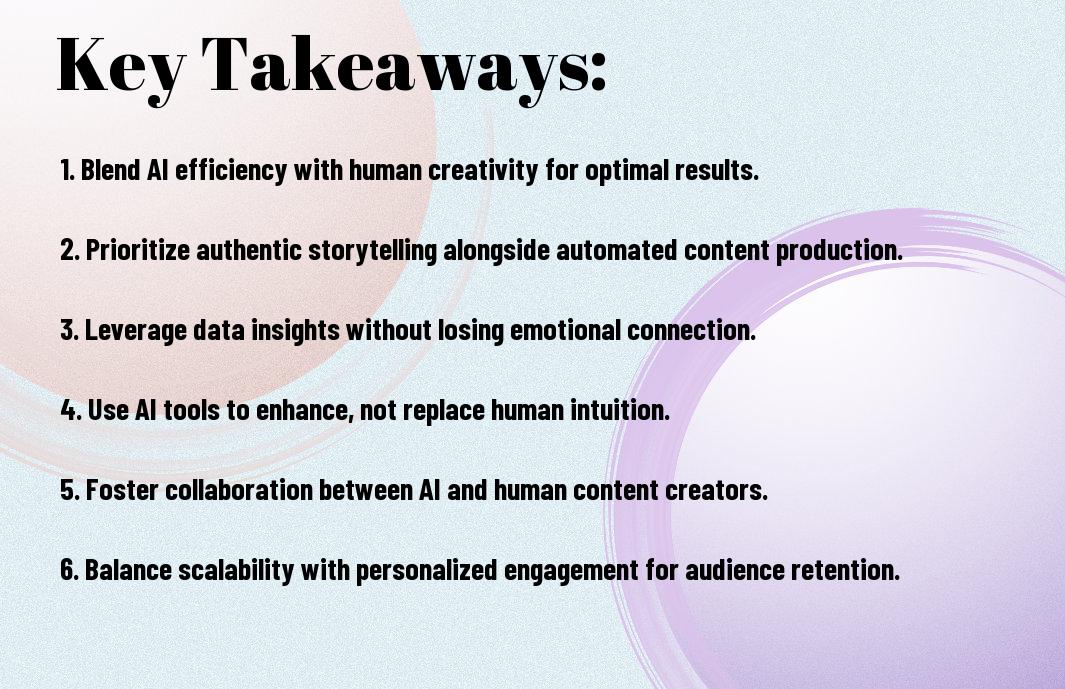
There’s a growing debate in the content strategy realm about how to effectively combine AI technology with the human touch to engage your audience. As you navigate this landscape, it’s imperative to recognize the strengths and weaknesses of each approach. While AI can enhance efficiency and data analysis, the emotional connection and creativity that human content creators provide are irreplaceable. This post will guide you in finding the optimal balance, ensuring that your content resonates authentically while leveraging the latest advancements in technology.

Key Takeaways:
- Human Connection: Personal connections foster trust and engagement, making them necessary in content strategy.
- Content Personalization: AI can enhance personalization by analyzing user data to deliver tailored experiences.
- Creativity: Human creativity is irreplaceable; blending AI’s efficiency with creative thinking results in innovative solutions.
- Scalability: AI tools provide scalability, allowing brands to produce content quickly while maintaining quality.
- Data-Driven Insights: Leveraging AI for data analysis helps in understanding audience preferences and optimizing content.
- Empathy: Human writers infuse empathy and emotion into content, creating more relatable narratives compared to AI-generated text.
- Continuous Adaptation: A successful content strategy requires ongoing adjustments based on AI analytics and human insights.

Understanding the Role of AI in Content Strategy
Your content strategy is evolving, and one of the key players in this evolution is artificial intelligence (AI). AI in content creation refers to the use of algorithms and machines to generate, curate, and distribute content, simplifying many of the labor-intensive processes that human content creators traditionally managed. Whether it comes in the form of sophisticated writing assistants or social media automation tools, AI is designed to augment your efforts by providing data-driven insights and efficiencies that were previously unattainable in a manual workflow.
Definition of AI in Content Creation
Role of AI in content creation can be transformative. By analyzing vast amounts of data, AI can identify trending topics, optimize headlines for better engagement, and even suggest keywords that enhance your search engine optimization efforts. This automated approach allows you to focus on higher-level strategic planning while leaving the repetitive tasks to machines. Instead of manually sifting through analytics, AI will provide you with actionable insights, resulting in a more streamlined content creation process.
Benefits of AI-Driven Content
Content creation with AI technology brings numerous benefits that can enhance your overall strategy. First and foremost, AI can significantly reduce the time required for content production, enabling you to produce and publish materials faster than ever before. Additionally, AI tools are capable of analyzing audience behavior, which helps you refine your content strategy to better meet your readers’ preferences. This data-driven process ensures that the content you create is not only relevant but also aligned with what your audience is actively seeking.
Due to its ability to analyze large datasets quickly, AI can also offer personalized content recommendations, which can drive higher engagement and conversion rates. By understanding what resonates with your audience, AI allows you to craft targeted messages that strike a chord with individual segments of your market. Moreover, AI’s predictive capabilities can help you anticipate future trends, giving you a competitive advantage in your content strategy.
Limitations of AI in Understanding Human Nuance
Across the landscape of content creation, there are inherent limitations when it comes to AI’s ability to grasp human nuance. While AI excels at analyzing data and producing content based on patterns, it lacks the emotional intelligence necessary to fully understand the subtleties of human interaction. This can lead to content that, while technically accurate, fails to resonate on a deeper emotional level with your audience.
Further, the inability of AI to comprehend context may result in content that misses the mark or is inappropriate for the intended audience. AI lacks the capacity to interpret sarcasm, humor, or culturally specific references, which can negatively impact your brand’s image if not carefully monitored. To create compelling content that connects with your audience, you must incorporate a human touch that AI cannot replicate, thereby ensuring that your messages are not only accurate but also engaging and relatable.

The Importance of Human Touch in Content
It is necessary to recognize the significance of incorporating the human touch within your content strategy. While artificial intelligence can analyze patterns, optimize content, and even generate text, it lacks the innate qualities that only humans possess. Elements such as empathy, creativity, and personal experience contribute to the formation of connections with your audience, enabling your message to resonate on a more profound level.
Emotional Intelligence in Content Creation
With the rise of digital communication, emotional intelligence has become a pivotal factor in content creation. Understanding your audience’s emotions allows you to tailor your messaging to meet their needs more effectively. By recognizing feelings such as joy, sadness, or frustration, you can create engaging content that speaks directly to them, fostering a sense of belonging and loyalty.
Your ability to infuse emotional intelligence into your content not only strengthens the bond you create with your readers but also enhances their overall experience. Connecting through shared emotions enhances the effectiveness of your message, ultimately driving higher engagement and conversion rates.
Building Brand Authenticity and Trust
The authenticity of your brand is foundational in cultivating trust with your audience. Your audience seeks genuine interactions and transparency when engaging with brands. By demonstrating commitment to your values and sharing your unique journey, you make it easier for potential customers to relate to your narrative, which can significantly impact their decision-making process.
A magnetic aspect of brand authenticity is its ability to foster a loyal community around your values. This loyalty strengthens relationships and encourages positive word-of-mouth marketing. When customers feel they can rely on your brand to be sincere and honest, they are more likely to advocate for your products or services and remain loyal in the long run.
The Role of Storytelling in Human Engagement
After all, storytelling is one of the oldest and most powerful tools in communication, allowing you to captivate your audience effectively. By weaving narratives that illustrate your brand’s values and mission, you invite your audience into your world, creating a more meaningful connection. Stories not only evoke emotions but also make your brand memorable, increasing the odds of your audience engaging with your content again and again.
Authenticity in storytelling is vital; when your audience detects that the story you share is genuinely yours, they feel an inner connection, deepening their engagement. This emotional bond may lead to increased loyalty and advocacy, aligning with your overall content strategy and ultimately fostering long-term success for your brand.

Identifying the Balance: When to Use AI vs. When to Engage Human Creators
After entering into the AI versus human creativity debate, you may wonder how to best strike a balance between the two. One approach is to first identify specific scenarios in your content strategy where each excels. You can explore insights on this topic by reading about AI vs. Human Creativity: Striking the Perfect Marketing Balance. This understanding will empower you to leverage the strengths of both AI and human creators effectively.
High-Volume Content Needs and AI Solutions
Between the demands of maintaining a consistent content calendar and producing large quantities of material, AI is your ally. It can quickly generate blog posts, social media updates, and even marketing emails, reducing the time-to-market while ensuring a steady flow of content. This capability allows you to focus on strategy and creativity, enabling you to allocate more resources to other important aspects of your business.
However, while AI can efficiently churn out content based on predefined parameters, it lacks the ability to infuse genuine creativity and understanding into each piece. This is where you need to evaluate the types of content you intend to create. For generic, high-volume demands, AI shines, but for nuanced topics that require human insight or storytelling, a human touch is necessary.
Situations Requiring Deep Emotional Connections
With emotionally charged content, the intricacy of human experience must guide your messaging. AI can analyze patterns and trends, but it cannot replicate the depth of human emotions or the subtleties in communication that resonate with an audience. Crafting compelling narratives that evoke feelings necessitate a human creator who understands the emotional landscape of your target demographic.
Moreover, your audience may connect more deeply with authentic stories that reflect their experiences, building loyalty and trust. While AI can help refine these stories or provide data-driven insights, the core narrative should come from human creators who possess empathy and emotional intelligence.
Understanding the essence of emotional storytelling is key. When your content aims to foster connections—whether it’s through personal stories, advocacy campaigns, or brand values—rely on the vibrancy of human insight, creativity, and authenticity. This emotional engagement will ultimately enhance the relationship between your audience and your brand.
Assessing Audience Expectations
With varying audience expectations across different platforms, identifying when to deploy AI and when to tap into human creativity is vital. Different demographics and niches may have diverse preferences for engagement levels, tone, and content types. Understanding these nuances allows you to tailor your approach, ensuring that your strategy is aligned with your audience’s needs.
The expectation landscape can change quickly, influenced by trends, cultural shifts, and evolving market conditions. Staying attuned to your audience’s feedback and preferences will help you gauge whether your content should resonate more deeply on a human level or if it can effectively be automated through AI solutions.
Balance your strategy by constantly reviewing audience expectations and adapting your content accordingly. Leveraging AI for content generation can streamline processes, but infusing your human voice ensures that your brand’s messaging remains authentic and relatable. By finding this equilibrium, you’ll be better positioned to meet both high-volume needs and deep engagement goals.
Case Studies of Successful AI and Human Collaboration
Now, let’s research into the transformative power of AI and human collaboration through specific case studies that showcase impressive results and novel strategies. These instances illustrate how integrating technology with personal touch can lead to remarkable outcomes.
- Spotify: Utilized AI algorithms for personalized playlists, boosting user engagement by 30% and increasing user retention rates to 90%.
- Netflix: Leveraged AI for content recommendations, which led to an increase in viewer hours by 75%. Their sophisticated algorithms analyze viewing habits to enhance viewer satisfaction.
- Unilever: Implemented machine learning in their marketing strategies, resulting in a 20% improvement in ad targeting effectiveness and reduced marketing costs by 15%.
- Amazon: Combined AI-driven product recommendations with human customer service, leading to a 40% increase in sales conversion rates during holiday seasons.
- Adobe: Employed AI through its Adobe Sensei platform for marketing content optimization, yielding a 30% enhancement in campaign performance for their clients.
Marketing Campaigns Enhanced by AI
Human creativity is complemented by AI’s analytical skills, producing standout marketing campaigns. Take the example of Unilever; their campaigns utilized AI-powered tools to analyze social media sentiment and customer behaviors, tailoring messages to resonate seamlessly with their audience. This approach heightened engagement and enabled them to deliver content that truly mattered to consumers, showcasing the potential of data-driven marketing.
Furthermore, Adobe’s integration of AI functionalities allowed marketers to predict trends and understand target demographics in depth. As a result, clients experienced significant improvements in campaign performance, allowing marketers to focus more on the creative aspects of their strategies. This synergy between AI efficiency and human intuition proves indispensable in today’s competitive landscape.
Brands That Flourished with Human-Driven Strategies
Beside the numerical prowess of AI, some brands thrived through a strong emphasis on human-driven storytelling and genuine connection with their customers. Brands like Coca-Cola capitalized on emotions, leading campaigns focused on unity and positivity, which resonated deeply with audiences. With a careful blend of authentic messaging and community involvement, they successfully fostered a loyal customer base.
Moreover, Patagonia’s commitment to environmental sustainability is a strong facet of their brand identity, aligning perfectly with the values of their target audience. This allows them to stand out in a crowded market and cultivate passionate customers who support their cause. The human element of these campaigns cultivates a profound relationship with their clientele, creating advocates rather than simply customers.
Case studies of brands like Coca-Cola and Patagonia demonstrate that a focus on human connection can lead to remarkable brand loyalty and advocacy. Their strategies highlight the importance of aligning with your audience’s values and creating messages that speak to their experiences. This emphasizes that, while data and technology are important, the genuine connection fostered through human-driven strategies can produce a significant impact.
Hybrid Approaches: Successful Implementations
Behind successful implementations, hybrid models have emerged as a preferred strategy for many brands seeking to balance AI efficiency with a human touch. A notable example is the online retailer Stitch Fix, which employs human stylists to collaborate with AI algorithms for personalized shopping experiences. This hybrid model resulted in over 200% growth, as customers feel personal attention while benefiting from smart technology recommendations.
Another example is Sephora, which uses AI to provide tailored product recommendations influenced by customer feedback and human stylists. Their interactive chatbot, combined with the expertise of beauty advisors, fosters a seamless shopping experience, leading to increased customer satisfaction and loyalty. This indicates that blending AI capabilities with human insights can yield superior outcomes, propelling brands towards success.
This convergence of AI and human-driven strategies can redefine what’s possible in your business. As the market continues to evolve, leveraging both systems creates a powerful synergy that harnesses technology’s capabilities while nurturing important human connections. This approach not only enhances performance but also builds a brand identity that resonates strongly with your audience.
Best Practices for Integrating AI and Human Expertise
Now, as you navigate the delicate balance between AI and human involvement in your content strategy, it’s important to establish a strong foundation. One way to do this is by setting clear content goals that align with both your brand’s vision and your audience’s needs.
Establishing Clear Content Goals
Below, you should articulate specific objectives that guide your content creation process. This involves identifying what you want to achieve, whether it’s increasing brand awareness, driving conversions, or enhancing customer engagement. By setting targeted goals, you can utilize AI tools to gather data and pinpoint trends that inform your strategy, ensuring that both AI and human contributions are aligned with these objectives.
Additionally, these goals should be flexible enough to adapt as you assess the performance of your content. Regular evaluation of your goals in conjunction with AI-driven analytics allows you to pivot and optimize strategies, blending human creativity with AI efficiency.
Collaborating Between AI and Human Teams
Human teams play an important role in interpreting data and nurturing the emotional intelligence that AI lacks. By facilitating collaboration between your AI tools and your human experts, you can capitalize on the strengths of both. Human insights can give context to the data provided by AI, ensuring that your content resonates on a deeper level with your audience.
Best practices in this collaboration involve regular meetings where team members can discuss findings from AI analytics and share creative ideas inspired by them. Encouraging an open dialogue fosters an environment where human creativity thrives while leveraging AI’s analytical prowess, leading to a more comprehensive content strategy.
Continuous Learning and Adaptation Strategies
After establishing collaboration, it’s vital to invest in continuous learning and adaptation strategies. Your team should always seek to integrate new technologies and methodologies that enhance efficiency and effectiveness. This means staying updated with the latest trends in AI and content creation, allowing you to refine your strategies proactively.
Moreover, fostering a culture of experimentation will empower your team to test and adapt new ideas without fear of failure. This mindset opens doors to discovering unique combinations of AI capabilities and human insights that can elevate your content strategy.
At the core of successful continuous learning is a commitment to feedback. Regularly solicit input from your audience and team members, using it not only to inform your content but also to improve the tools and processes you employ. This ongoing cycle of learning and adaptation is vital for staying relevant in a rapidly changing digital landscape.
Future Trends in AI and Content Development
All the evidence points to a future where AI technologies will fundamentally reshape the landscape of content development. As these tools become more sophisticated, emerging technologies are beginning to redefine the way you approach content creation and distribution. This includes advancements in natural language processing, image generation, and even video content creation. By harnessing these capabilities, you can expect a significant boost in your productivity and creativity, allowing you to engage your audience more successfully than ever before.
Emerging Technologies in AI Content Creation
Among the exciting developments in AI content creation are tools that leverage deep learning and machine algorithms to produce high-quality text, visuals, and audio. These tools are designed to enhance the efficiency of your content strategy, minimizing repetitive tasks and freeing up your time for more strategic thinking and creative pursuits. The integration of machine learning enables these tools to learn from your inputs and continuously improve their outputs, which means that your future campaigns could be more personalized and aligned with current trends.
As you adapt to these emerging technologies, it’s vital to understand their role not only in boosting production but also in influencing how your audience perceives your brand. Technologies like generative design and automated content curation can help tailor experiences that speak directly to your audience’s preferences and needs, paving the way for a more engaged community around your brand.
The Evolving Role of Human Creators
Any successful content strategy will continue to require the unique insights and emotional intelligence that only human creators can provide. AI may excel at analyzing data and automating processes, but it lacks the depth of understanding that comes from real-life experiences and authenticity. As a content creator, your role will likely evolve to focus more on strategic decision-making and creative direction, guiding AI tools rather than being replaced by them.
Technologies will continue to change the way you approach storytelling and audience engagement. As AI takes over more routine and analytical tasks, it will be up to you to infuse your unique voice and perspective into your content. This human touch not only differentiates your brand but also builds trust and connection with your audience. Therefore, your role will evolve into that of a curator and storyteller, choosing how best to leverage AI-generated content while maintaining a distinctive and relatable brand identity.
Predictions for Industry Changes
Before stepping into these new trends, it’s important to consider how current shifts in AI will impact content strategies across various industries. Your ability to adapt will determine whether you can utilize AI as a tool for greater outreach and engagement or if you risk falling behind in an increasingly competitive landscape. You should prepare for a future where AI not only automates processes but also enhances the decision-making capabilities within your content strategy.
Creators who actively embrace AI technology will likely find themselves at an advantage as they leverage these tools to enhance their creative capabilities and improve audience engagement. As AI evolves, expect a shift towards more personalized and data-driven content, which can lead to greater audience retention and loyalty. Prioritizing the balance between AI capabilities and your unique input will be key in navigating this ever-evolving landscape.
Ethical Considerations in AI Content Use
Keep in mind that the use of AI in content creation carries significant ethical considerations. As you navigate this landscape, it’s important to ensure that your audience understands when content has been generated by AI. Transparency in disclosing the use of AI can enhance credibility and foster trust among your readers. If you are producing articles, blog posts, or marketing materials with AI assistance, consider including a note that explains the role AI played in generating the content. This fosters a more informed audience who is aware of the technologies influencing what they read.
Transparency in AI-Generated Content
With the rapid growth of AI technologies, you must address the challenge of making your audience aware of AI-generated content. Disclosing the use of AI not only helps establish your authenticity but also allows your readers to critically assess the information presented to them. By openly sharing how AI contributes to your content creation process, you empower your audience to engage with the material more thoughtfully.
Addressing Bias and Fairness in AI Algorithms
Algorithms that generate content are often trained on large datasets, which can sometimes include biased or incomplete information. Understanding this fact is vital for you to address potential inequities that may emerge from AI-generated content. If your content leverages AI, it is imperative that you evaluate the sources that feed into these algorithms, ensuring they reflect a balanced perspective. This helps in minimizing the risk of perpetuating stereotypes or unfair narratives that could arise from the AI’s output.
The challenges posed by bias in AI algorithms highlight the importance of responsible data sourcing and curation. You can make significant strides toward promoting fairness in your content by actively engaging with algorithms that prioritize diversity in their training datasets. As a content creator using AI, it’s your responsibility to critically assess both the technology and the information it produces, striving to mitigate any lingering biases in the content you share.
Stakeholder Responsibilities
Transparency around AI’s role in content creation involves various stakeholders, including you as the content creator, the developers of AI tools, and the audience who consumes the content. You have a responsibility to ensure the information you provide is accurate and equitable, but so too do the AI developers in producing tools that minimize bias and promote ethical usage. By working collaboratively, all parties involved can contribute to a landscape that values strong ethical standards in AI-generated content.
Considering these responsibilities lends weight to your role in the ethical use of AI in content strategy. You should advocate for guidelines that ensure AI algorithms are regularly audited for bias and fairness. This proactive stance promotes a shared commitment to ethical practices among stakeholders, ultimately benefiting not just your content, but the wider community who consumes it.
Final Words
Hence, finding the right equilibrium between AI and the human touch in your content strategy is fundamental for maximizing engagement and effectiveness. As you navigate the rapidly evolving landscape of digital communication, it is vital to recognize the unique strengths of both AI tools and human creativity. AI can process vast amounts of data and identify patterns, making it invaluable for data-driven tasks, such as audience segmentation and content personalization. However, the emotive nuances and authentic storytelling that humans provide are indispensable for forging genuine connections with your audience.
By thoughtfully integrating AI capabilities while fostering a personal touch in your content, you can enhance your overall strategy. Seeking guidance on When to Use AI and When to Add a Human Touch can help you make informed decisions that resonate with your audience. Ultimately, it is the combination of efficiency and empathy that will set your content apart and drive lasting impact.
FAQ
Q: What is the main difference between AI-generated content and content created by humans?
A: The primary difference lies in the creation process and emotional connection. AI-generated content relies on algorithms, data patterns, and pre-existing knowledge to generate text. In contrast, human-created content is enriched with genuine emotions, personal experiences, and insights that resonate deeply with audiences. While AI can produce high volumes of content quickly, it often lacks the unique voice and emotional depth that human writers bring to the table.
Q: How can businesses effectively integrate AI and human touch in their content strategy?
A: Businesses can strike a balance by using AI for data analysis, content optimization, and generating initial drafts. Once the AI has provided a base, human writers can enhance the content by adding creativity, context, and a personalized approach. This collaborative model allows companies to maintain efficiency while also delivering engaging and authentic content that connects with their audience.
Q: Are there specific types of content where human touch is more important than AI?
A: Yes, certain types of content particularly benefit from a human touch, such as storytelling, opinion pieces, emotional narratives, and any content that requires sensitivity or in-depth knowledge of human experiences. For example, pieces focused on mental health or social issues often need the empathy and nuanced understanding only a human can provide, making the human touch vital for authenticity and relatability.
Q: In what ways can AI enhance human-led content creation?
A: AI can enhance human-led content creation by providing valuable insights through data analysis, identifying trending topics, and suggesting keywords for SEO optimization. It can also assist in streamlining the editing process, analyzing performance metrics to inform future strategies, and generating ideas that inspire human authors. This partnership allows for both efficiency and creativity, ultimately improving the overall quality and reach of the content.
Q: What should marketers consider when deciding to use AI in their content strategy?
A: Marketers should consider the target audience’s preferences and the nature of the content they wish to produce. Understanding the balance between automation and authenticity is crucial, as poorly executed AI content can feel impersonal and disengaging. Additionally, they should evaluate the specific needs of their brand and industry, determining areas where AI can add value without undermining the human connection that is often pivotal in establishing trust and loyalty among consumers.





